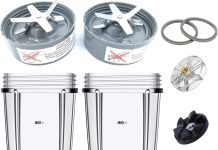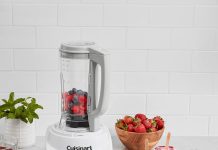So you’ve always wondered if your blender can double as a food processor? Look no further, because we’re here to give you the answer! In this article, we’ll explore the similarities and differences between blenders and food processors, and whether or not you can use them interchangeably. Whether you’re looking to make smoothies or chop vegetables, we’ve got you covered. Get ready to unlock the full potential of your kitchen appliances!
Review contents
Blender vs Food Processor
Blenders and food processors are two kitchen appliances that often confuse people due to their similarities in appearance and functionality. However, there are key differences between the two that make them distinct from each other. At the same time, there are also some similarities that make them interchangeable in certain instances.
Differences between a blender and a food processor
Blenders are designed primarily for liquids, blending ingredients into smooth mixtures. They are equipped with a tall, narrow container and sharp blades that pull the ingredients downwards. On the other hand, food processors have a wider and shorter container with multiple blades that spin in various directions. This design allows the food processor to chop, shred, and slice ingredients with precision and control.
Similarities between a blender and a food processor
While blenders and food processors have fundamental differences, there are some similarities that make them versatile and capable of performing certain tasks interchangeably. Both appliances can be used for tasks such as pureeing, grinding, and mixing ingredients. Additionally, they can handle similar ingredients like fruits, vegetables, and even some grains. However, it is important to note that each appliance has its own strengths and limitations.
Using a Blender as a Food Processor
Although a blender is not specifically designed to function as a food processor, it can still be used as a substitute when necessary. Understanding the advantages and limitations of using a blender for food processor tasks can help you make informed decisions in the kitchen.
Advantages of using a blender as a food processor
One of the primary advantages of using a blender as a food processor is its ability to blend liquids and create smooth mixtures effortlessly. Blenders are particularly useful when making smoothies, soups, and sauces, as they can break down ingredients into a consistent texture. Additionally, blenders are often more affordable and take up less countertop space compared to food processors.
Limitations of using a blender as a food processor
While blenders can effectively handle liquid-based tasks, they may struggle with certain dry ingredients or tasks that require precise chopping or slicing. Due to their tall and narrow containers, blenders may have difficulty processing smaller quantities of ingredients or achieving uniform results when chopping or grating. Furthermore, blenders may not have the same level of control and variety in blade speed and motion as food processors, which can impact the texture and consistency of the final product.
Blender Functions That Can Replace Food Processor
If you find yourself needing to use a blender as a food processor, there are several functions that a blender can successfully perform.
Blending
Blenders excel at blending ingredients together to create smooth and consistent mixtures. Whether you want to blend fruits for a refreshing smoothie or create a creamy soup, the blender can handle these tasks effectively.
Pureeing
When it comes to breaking down ingredients into a smooth and uniform texture, blenders are the go-to appliance. Whether you’re making baby food or pureeing cooked vegetables for a sauce, the blender can achieve the desired consistency.
Grinding
Certain blenders are equipped with grinding blades that can grind ingredients, such as coffee beans, spices, or nuts, into a fine powder. However, it is essential to ensure that your blender is suitable for grinding tasks and follow the manufacturer’s guidelines.
Mixing
Blenders are excellent at mixing ingredients together, especially when it comes to liquids and batters. From pancake batter to cake batter, blenders can effortlessly combine the necessary elements for your recipes.
Chopping
While blenders may not have the same precision as food processors when it comes to chopping, they can still handle softer ingredients like onions, garlic, and herbs. By pulsing the blender a few times, you can achieve a coarsely chopped texture.
Grating
Some blenders are equipped with shredding or grating attachments that allow you to grate ingredients like cheese, carrots, or cabbage. These attachments can be a convenient alternative if you don’t have a food processor on hand.
Tips for Using a Blender as a Food Processor
Using a blender as a food processor requires a few adjustments and considerations to achieve the best results. Here are some tips to help you make the most of your blender when substituting it for a food processor.
Choosing the right blender
If you plan on using your blender for food processor tasks frequently, consider investing in a high-quality blender that offers more versatility and control. Look for blenders that have variable speed settings, different blade options, and additional attachments for grinding or grating.
Cutting ingredients into smaller pieces
To ensure more even processing, especially when chopping or blending dry ingredients, it is helpful to cut them into smaller pieces before adding them to the blender. This will help avoid uneven results and ensure that all the ingredients are properly processed.
Working in small batches
Due to the narrow container of blenders, it is important to work in smaller batches when using them as a food processor. Overloading the blender can hinder the effectiveness and may lead to uneven results. It is best to process ingredients in smaller quantities and repeat the process if necessary.
Pulsing vs Continuous blending
When chopping or blending ingredients, it is often more effective to use the pulse function on your blender rather than continuous blending. The pulse function allows for better control, allowing you to achieve the desired texture without overprocessing or creating an uneven mixture.
Adding liquid when necessary
Blenders rely on liquid to create a smooth and consistent blend. When using the blender as a food processor, ensure that there is enough liquid to aid in the blending process. This is particularly important when pureeing or processing dry ingredients to prevent the blender from overheating or producing an unsatisfactory result.
Blender Recipes That Can Be Made without a Food Processor
Blenders can be a versatile tool in the kitchen and can help you prepare a variety of delicious recipes that traditionally require a food processor.
Smoothies
Blenders are the perfect appliance for making smoothies. Simply combine your favorite fruits, some liquid like milk or juice, and any additional ingredients like yogurt or protein powder. Blend until smooth, and you have a delicious and nutritious beverage.
Soups
Blenders can also be used to make creamy and velvety soups. Cook your vegetables until tender, transfer them to the blender with some broth, and blend until smooth. If desired, you can strain the soup for an even smoother texture.
Sauces and Dressings
Whether you’re making a classic tomato sauce or a tangy salad dressing, blenders can help you achieve the perfect consistency. Blend together your desired ingredients, adjusting the seasonings to taste, and enjoy a homemade sauce or dressing.
Nut Butters
While food processors are typically recommended for making nut butters, certain high-powered blenders can also handle the task. Simply blend your choice of nuts until smooth and creamy, adding a touch of oil if necessary. Homemade nut butter has never been easier!
Dips and Spreads
From hummus to salsa, blenders can effortlessly create delicious dips and spreads. Combine your choice of ingredients, such as chickpeas, garlic, tahini, or tomatoes, in the blender and blend until smooth. Adjust the seasonings to taste, and your dip or spread is ready to be enjoyed.
Conclusion
While blenders and food processors may have their own distinct features and purposes, blenders can be a suitable alternative for certain food processor tasks. By understanding their capabilities, limitations, and employing some helpful tips, you can make the most of your blender in the kitchen. So, the next time you find yourself without a food processor, don’t fret – your trusty blender can come to the rescue!































